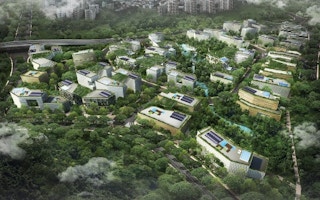Singapore’s building industry has fewer excuses not to track its carbon footprint after experts unveiled new tools for calculating carbon emissions on the final day of the three-day International Green Building Conference.
Professor Huang Yi Chun from the architecture department at the National University of Singapore (NUS) said at an industry workshop for about 100 professionals that his aversion to data entry prompted him to develop his automated carbon calculator for architects.
“Every hour spent answering questions for computers is one hour too long,” he said.
The software plug-in he developed uses the standard 3D architectural designs – known as BIM technology - that developers submit to Singapore’s Building and Construction Authority to calculate the carbon footprint of proposed buildings, and requiresno extra data input, he added.
In the design stage, many features of a building have not yet been determined – making accurate carbon calculations difficult to do, he noted.
Architects who want to keep an eye on the carbon footprint from the beginning of the design process can use the programme’s ability to make assumptions based on data from similar building types in Singapore. They can then gauge the impact of anyadded features – such as solar panels or extra vegetation – on the building’s carbon footprint.
Dr Huang compared the Automatic Carbon Calculator to predictive text on mobile phones, which fill in text based on partial information. “It is useful right from the planning stage – something that is absent from carbon calculators today.”
Funded by government-backed industrial developer JTC Corporation, the calculator uses data geared towards industrial buildings in its current, first version, which is not yet available to the public. However, Dr Huang said, the basic programme will work for any building type.
JTC is in the process of identifying projects to try out the new tool, which calculates the emissions from a building’s construction and operation - and several other developers have shown an interest, he told Eco-Business after the workshop.
Professor Huang used internationally accepted figures for emissions from construction. However, the database will soon be improved with figures specific to Singapore, he said.
He is working closely with Professor Evelyn Teo Ai Lin from the NUS department of building, who presented the second carbon calculation tool at the workshop - the Carbon Index for Construction Projects.
A Ministry of National Development (MND)-funded project, the Index came about from feedback that emissions data was extremely difficult to obtain from within the industry. Companies were not sure how to collect the information, said Dr Teo at the workshop.
The free tool for contractors, developers, manufacturers, and suppliers - available at carbonindexcalculator.com - requires no training and can integrate data from multiple contractors and suppliers for a single project in one place.
The information will help builders benchmark their projects against industry standards, and will also add to a national database on the carbon embedded in common construction materials and activities, including transportation, noted Dr Teo. She added that transportation was a key area for Singapore, because most of its materials were imported and had higher carbon emissions as a result.
The third carbon tool presented at the workshop was the Green Mark Carbon Calculator developed by Building System & Diagnostics (BSD), a private building consultancy with roots at NUS.
BSD worked with BCA and industry partners to build an online tool that builders can use to fulfil carbon footprinting requirements for BCA’s Green Mark building certification scheme.
BSD director Yong Ping Quen said the tool was simple to use – taking an average of 20 minutes – and was accurate to within two per cent.
The firm developed the project based on consultations within the industry and on test cases using existing buildings that had already been Green Mark-certified and audited.
“It may not give you an absolute, accurate number. But for comparison, it’s quite useful,” he said.
Available on the BCA website, the Green Mark Carbon Calculator allows builders to quantify the carbon impacts of each carbon-related Green Mark criteria based on information from local agencies. For example, water consumption figures use carbon emissions data for water treatment from Singapore water agency PUB, and emissions data for electricity consumption from the National Environment Agency.
For data that builders cannot provide, they can select ‘unknown’ and the programme will substitute a default value. Once completed, the programme provides a comparison of the building project to a model building based on a basic Green Mark certification.
BSD tried to develop the calculator for the Singapore context to provide better accuracy and to help refine future versions of the Green Mark scheme, said Mr Yong.
NUS’s Professor Huang said that the Green Mark Carbon Calculator would facilitate the submission of projects to BCA by builders.
In contrast, the automatic carbon calculator “would result in BCA receiving better designs”, he added.
Eco-Business.com’s coverage of the International Green Building Conference 2012 is brought to you by City Developments Limited (CDL).













